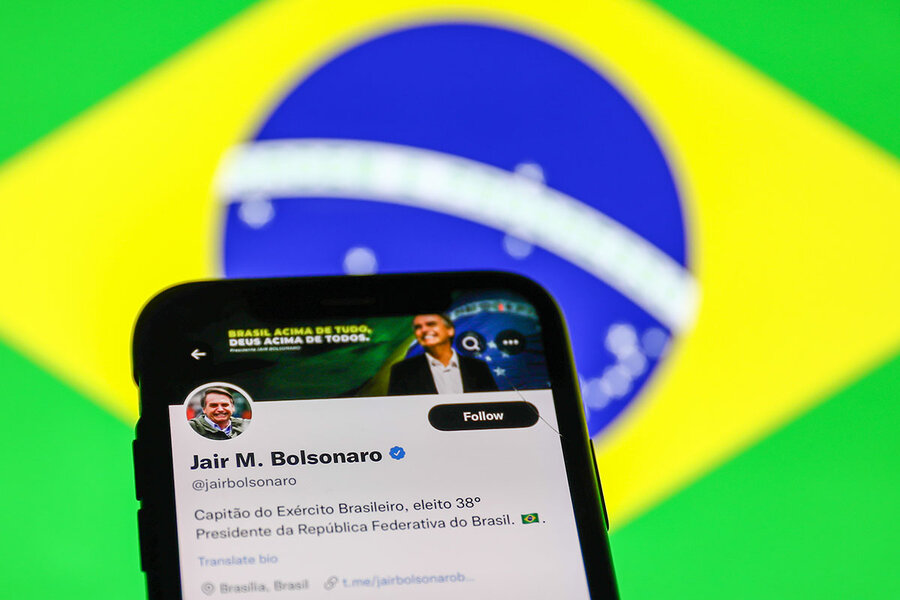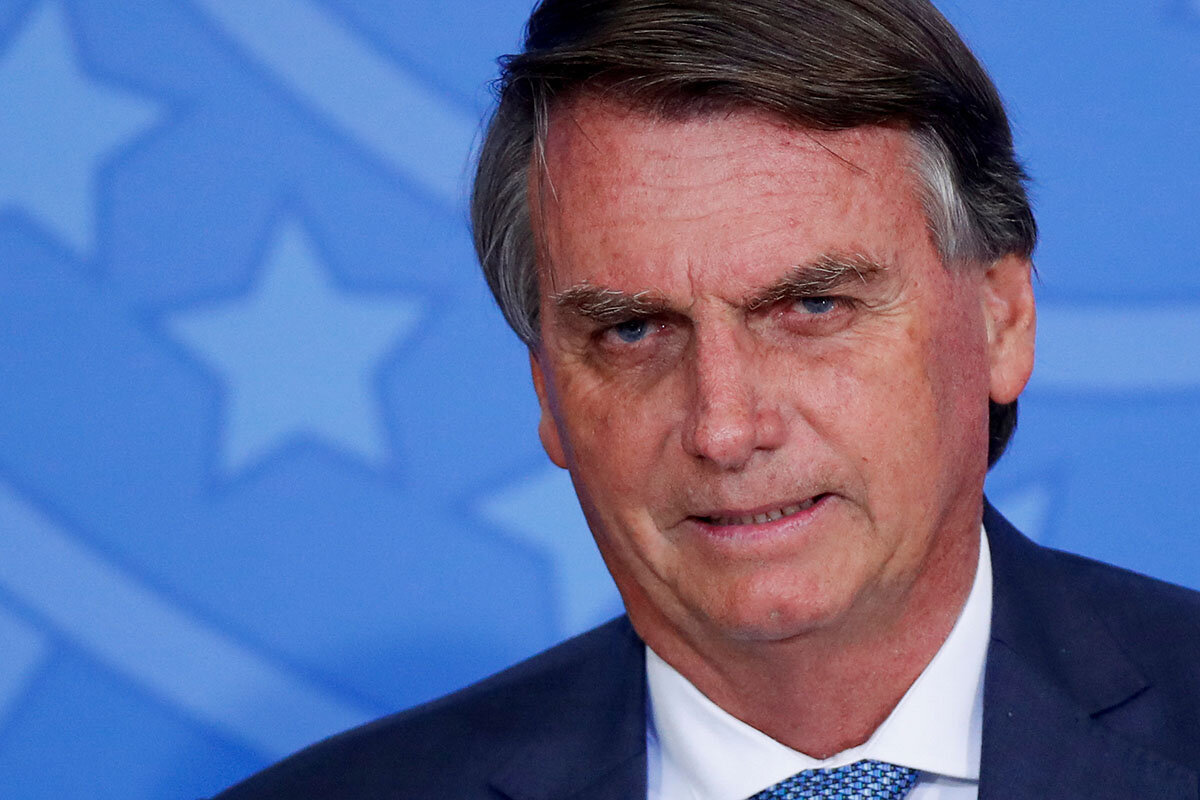Can Brazil stamp out fake news ahead of presidential elections?
Loading...
| Rio de Janeiro
Whenever a story with a wild headline came her way, Mary Rose Filgueiras Lacerda used to skim it and forward it on without any second thoughts.
But when the eye-popping stories arrived with more frequency on WhatsApp, she got suspicious. “I thought, this is strange. It can’t all be true,” says Ms. Lacerda, a retiree who lives in Divinópolis, in Brazil’s Minas Gerais state.
She decided to take action, enrolling in a digital course teaching Brazilians over the age of 50 how to spot fake news. Over five days, daily messages urged her to read beyond the headlines and to double check her sources. Short YouTube videos taught her how to spot fakes and detailed how videos, images, and memes can be doctored.
Why We Wrote This
Fake news has been a global scourge, but Brazilians’ heavy use of social media makes them particularly susceptible. Now, Brazil is trying its hand at setting an example for beating back misinformation.
“I confess I used to forward lots of fake news, because I thought they were true,” Ms. Lacerda says. “What I learned ... showed me we need to stay alert.”
Ms. Lacerda’s concerns are not misplaced. Fake news and misinformation campaigns have hit Brazil hard over the past five years. And even with Brazil’s presidential elections still months away in October, fake news about the upcoming election is already spreading across platforms like WhatsApp, Facebook, Telegram, and TikTok.
Fake news has been a global scourge in recent years, with online messaging services and social media often overshadowing traditional media as go-to sources of information. The phenomenon has left a profound mark on Brazil, where experts say low education levels, mistrust of institutions, and heavy social media use have created a perfect breeding ground for misinformation.
Brazil is one of the world’s heaviest users of social media, with about 159 million – or 75% of the population – on at least one platform. And the way messages are sent, relying more on voice memos or images overwritten with text, makes them hard to screen en masse. In 2018, a torrent of disinformation favoring President Jair Bolsonaro helped sweep the far-right candidate to a surprise victory.
And although a fresh wave of election disinformation is fueling concerns about Brazil’s democratic health, the South American giant may also be offering new paths toward combating it. Congress has proposed legislation to curb the spread of fake news. The Supreme Court is trying to force social networks to more effectively police users. Brazil’s electoral court has struck deals with tech giants to screen out fake news and report those who create it to authorities.
And nongovernmental organizations are working to teach digital literacy and fact-checking, in hopes that with a little help, citizens can identify misinformation and play a central role in stopping its spread in their communities.
“We end up with multiple versions of the truth out there, circulating,” says Valerie Wirtschafter, a senior data analyst at The Brookings Institution, who studies misinformation in Brazil. “That’s problematic, because we know that an informed voter is what underpins democracy.”
Who is responsible?
Brazilian lawmakers have wrestled with how to crack down on disinformation for years. And it’s not just around elections – misinformation flourished during the pandemic.
Legal efforts culminated in a sweeping legislative proposal known as the “Fake News Bill,” which seeks to criminalize the spread of fake news and force social media platforms to identify financial backers of such posts. It would also limit the reach of mass messages on platforms like WhatsApp.
But the legislation, first introduced in 2020, has drawn fierce criticism from technology companies, civil society, and free speech advocates. Among its most vocal critics is President Jair Bolsonaro, who is himself under federal investigation for spreading misinformation on social media during the pandemic – including false claims that COVID-19 vaccines might raise the chance of contracting AIDS.
“The bill is not perfect, but it’s a good start,” says Felipe Nunes, a political scientist at the Federal University of Minas Gerais who studies public opinion and social media. “It has been met with a lot of resistance though.”
Last month, the bill suffered a major blow when Congress rejected an attempt to fast-track it, making the bill unlikely to advance before October’s vote.
Mr. Bolsonaro is facing off against former President Luiz Inácio Lula da Silva this fall. Mr. Silva, known widely as Lula, is leading early polls with 45% of the vote, to Mr. Bolsonaro’s 31%.
Last year, Mr. Bolsonaro unsuccessfully tried to ban social media platforms from removing content and users. But platforms like YouTube, Facebook, and Twitter have taken down videos of him promoting unproven “miracle cures” for COVID-19 and peddling false claims about 2018 election fraud.
Even if legislation criminalizing fake news advances, it may be difficult to implement because it would require global tech giants to usher in sweeping policy changes.
But the power of Brazil’s courts in forcing the hand of tech platforms became evident earlier this year, when a Supreme Court judge banned Telegram after Brazil’s federal police had repeatedly tried to get in touch with the platform to request the removal of what it deemed dangerous content. The messaging app then came around, signing on to rules governing misinformation set out by electoral officials.
“We will only reach a solution when platforms are made responsible for identifying and helping authorities to criminally punish those who produce fake news,” says Mr. Nunes.
New challenges
For the fake news machine churning out false information, the pandemic proved a boon.
Producers of misleading content were able to hone their craft, says Sérgio Lüdtke, who leads the Comprova Project, a monitoring collective made up of 40 Brazilian media outlets and funded by Google and Meta, the parent company of Facebook.
“It was almost like a training ground for them in what works and what doesn’t,” Mr. Lüdtke says.
Those spreading disinformation are growing more sophisticated, experts say. False messages have become increasingly subtle in how they convey their version of the news, omitting context or inviting misinterpretation instead of offering up overtly fabricated storylines. Brazilians fall for fake news more than their counterparts in other countries battling misinformation such as the United States and Italy, a 2020 study concluded, with 73% believing at least one false claim during the pandemic.
“It’s no longer necessary to invent a whole new narrative” when spreading misinformation, says Mr. Lüdtke. “It’s enough to raise doubt, to suggest a link that isn’t there, and to let people draw a false conclusion.”
This is making the work of initiatives like Comprova more painstaking. The group is currently running the course in which Ms. Lacerda and upwards of 2,200 others took part, in hopes of teaching Brazilians who didn’t grow up as digital natives how to spot fake news. “We have to figure out how people are interpreting this misleading information and then deconstruct that narrative,” Mr. Lüdtke says.
False information tends to bolster the beliefs of voters who have already picked sides, not necessarily change someone’s position, a study led by Mr. Nunes found.
“Fake news doesn’t serve to manipulate people’s opinions,” he says. It “serves to engage and mobilize people in electoral processes. ... It’s election gold.”
Standing up to disinformation
Despite the vast presence of fake news, those trying to fight the phenomenon are feeling hopeful. Ariel Freitas works for Voz das Comunidades, a favela-based news organization that is actively fighting election disinformation.
“We’re seeing all kinds of efforts to ... trick people,” Mr. Freitas says, whose team creates fact-checking posts to share on social media and Voz das Comunidades’ mobile app. But “we are much better prepared than we were in 2018.”
For one, grassroots journalists and activists have fine-tuned their skills, he says, improving how they monitor misinformation and reach people via social media who may not watch, read, or listen to traditional news outlets.
Voz das Comunidades is about to launch an elections-specific fact-checking project that will verify the claims of candidates and send out push notifications warning about false information making the rounds on messaging apps and social media.
“We’re stronger now. We can stand up to the disinformation,” Mr. Freitas adds.






